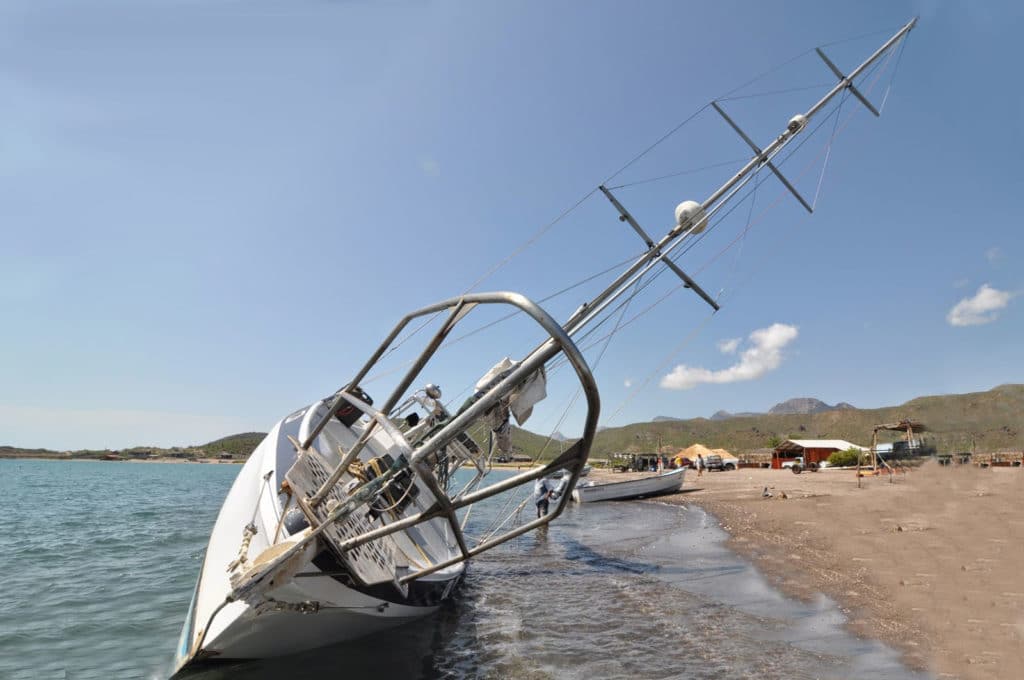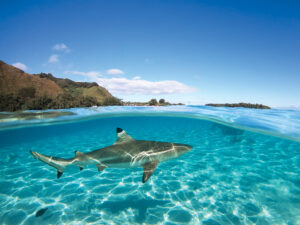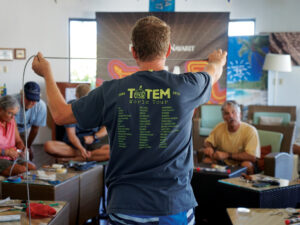
NOTE: Rather than use the real name, I made up the boat name Pantheon for this story, simply because it’s a personal matter and I don’t know the boat owner well. Of course, everything is otherwise true. And in case you missed the previous post, you should probably read that first.
I lost VHF contact with the Pantheon crew before dusk, the same day they wrecked ashore. Nobody in La Paz had heard from Will, the guy who jumped in his SUV after my first contact with Pantheon and headed north to San Evaristo to make contact and retrieve crew. Nobody knew exactly how bad the roads were and we weren’t even sure Will ever made it there.
Shortly after sunrise, Christian on Mana Kai offered to drive his extended cab Ford F-350 on the four-hour trek north to San Evaristo and to the wreck of Pantheon. Tom on Eagle and I gathered tools and food and water and joined him. Thirty minutes into the trip, my handheld VHF crackled and we all learned that Pantheon‘s crew and skipper arrived back in La Paz at midnight the night before, that some of his stuff was in a pile on the beach. We hailed him and said we were en route and asked if we should continue and if so, when we arrived should we continue salvaging stuff from his boat.
It was obvious from his response that he was still in shock, but he did ask us to please continue on, to salvage everything we could from his boat, and then he thanked us profusely. He said he planned to retrieve his jeep and trailer, drop family off at the airport, and head for San Evaristo a few hours behind us.
It was a long, rough road and the suspension on the F-350 is jarring. We were taxed when we arrived at about 11:00 a.m.
The sight of a 40-foot cruising boat on the beach, her port lights underwater and sand berms forming around her, is disquieting. Climbing aboard to find familiar things like the galley oven, underwater, is worse. Doing so when the boat is heeled over 60 degrees is surprisingly difficult.
So we got to work, unscrewing solar panels, winches, cleats, blocks—anything of value, and making an ever-larger pile on the beach. The thought that kept going through my mind was how great the difference was between the time I spent removing things and the time that someone spent years before to purchase and measure and tap and bed and attach each of these same things. Where things had been carefully installed, we pried and cut and ripped to remove them as quickly and easily as possible. Screws regularly fell and hit the deck and disappeared into the surf and it didn’t give me pause. We cut standing rigging to retrieve the Norseman fittings and then watched the mast buckle and crash to the sand.
But other things, like a new, 30 GPH CruiseRO watermaker, had to be disconnected carefully to preserve its value. Tom spent nearly two hours waist-deep in sea water, on his head, with one hand behind his back and a flashlight in his mouth to untangle the system—especially the engine-driven compressor from the Perkins 4108.
Inside, I alone was the arbiter of what to take and pass up through a hatch; I couldn’t get it all. Some items were obvious, like a small, ornate keepsake box filled with black and white photos and war medals. But I left piles of books, any one of which may have held meaning for the owner, but which may be wet and irretrievable by the time he returned.
In the end, we did an amazing job, literally stripping the boat nearly bare in four hours, then loading trucks for the longer, slower ride home.
The San Evaristo residents, largely members of a small fishing co-op, will use and repurpose most of what we didn’t remove. The mast and other aluminum parts have intrinsic recycling value. All of the stainless we didn’t remove will be repurposed or sold—along with the few winches we didn’t remove. The engine will be a bear to extricate, but they’ll do it and its service life may outlast many of us. I’m sure that by now they’ve removed the 8D battery that was still high and dry and that they’ve pumped the diesel tanks empty. The other, submerged batteries will be sold as cores. All of the teak bits will be reused.
And that leaves the hulking fiberglass hull. I remember when I interviewed Jeanne Socrates ahead of her record-breaking trip, she said that one year after she wrecked her Najad 36 on a Mexican beach (just south of Zihuatenejo, roughly 60 miles short of completing a circumnavigation) she returned to thank the people who helped her. All that remained visible of her boat was the tip of the mast, poking up through the sand, the rest of it subsumed. Pantheon was already, obviously starting that journey only hours after she washed ashore.
Oh, and what caused the loss of a boat and dream? Well, when the same front that passed over La Paz hit San Evaristo, Pantheon‘s CQR held fast, set in about 25 feet of water. The rode was about 50 feet chain and then rope, secured to a Sampson post—a Sampson post that was hollow and appeared cast. It sheared under load, leaving the boat hanging on the rode where it had been attached downstream of the post. But the jagged metal base of the sheared post quickly chaffed through the rode and set Pantheon adrift and unplanned events in motion.
It’s likely, at the next cruiser’s swap meet here in the La Paz, that much of the stuff we removed from Pantheon will be sold for a fraction of what they cost. Her former owner will get a bit of relief, but he won’t be close to being made whole. As I suspected, his boat (like ours and many others) is uninsured. Maybe he’ll gather the resources and the disposition to start anew, with his next boat. More than likely, he’ll close the cruising chapter of his life and move on.








